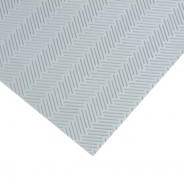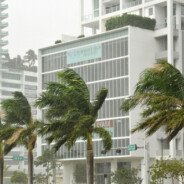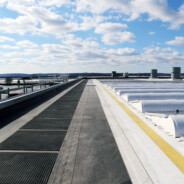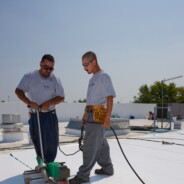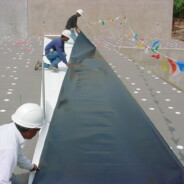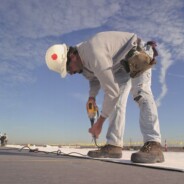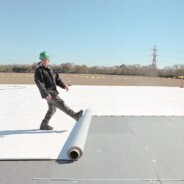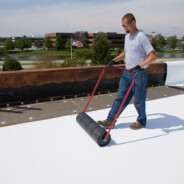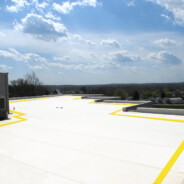Roofing Safety
Winter Safety Tips for Roofing Contractors
It’s December and for those of us in cold climates, it is time to be thinking again about winter safety. Here are some things to keep in mind. Winter Fall Safety Falls are always a concern for roofers, but when you add ice and snow to the mix, your crew must be prepared. In addition to all of your normal fall prevention procedures, make sure to warn your crew that a layer of snow can be covering a dangerous ice layer. Make them aware that deep snow can cover trip hazards such as conduits and pipes. Drifting snow can also cover skylights, so have the building management point out their locations to your crew prior to them getting onto the roof. Set up safety guard rails on the parameters of the roofs for added protection. Remember...
read moreWalkway Pads: Protection for Your Roofing Investment
It is sometimes assumed that since workers aren’t on a roof every day that worrying about how your roof handles foot traffic is not important. However, today more than ever, roofs are experiencing more foot traffic than you may realize. The typical building rooftop is becoming a crowded place. Technology such as Wi-Fi antennas, satellite and microwave dishes, cell phone communication equipment and solar panels have joined HVAC systems, pipes, ducts, conduits, skylights, elevator equipment and more, all requiring access and maintenance. Green roofs are also becoming more popular and definitely require accommodations for the additional foot traffic. Not to mention the roof itself needs to inspected and maintained on a regular basis....
read morePreparing for Tropical Storms
Just because it is November does not mean you no longer have to worry about hurricanes. As Yogi Berra said, “It ain't over till it's over.” In fact, the official Atlantic hurricane season lasts until November 30. The month of November has had some significant hurricanes including the Cuba hurricane in 1932, a Category 5; Hurricane Lenny in 1999, a Category 4; Kate in 1985, Hurricane Paloma in 2008, and Ida in 2009. Karen Clark & Company (KCC), a leading catastrophe modeling company for the insurance industry, estimates that hurricanes can cost insurers billions of dollars for storm damage. And that doesn’t include the wreckage left behind to buildings, contents, automobiles and for lost time. According to KCC’s report, the...
read moreFall Protection
In April 2016, a 24-year old roofing worker died on the job due to the failure of his employer to have adequate fall protection and training, according to federal investigators. Unfortunately, he was not alone. Falls are the leading cause of death in the construction industry. According to the Bureau of Labor Statistics, the fatal work injury rate for roofers in 2014 was 46.2 per 100,000 full-time equivalent (FTE) workers. The Occupational Safety and Health Administration (OSHA) takes this issue seriously and will cite and fine roofing companies for failure to provide adequate fall protection. Just to name a few, on September 8, 2016, OSHA cited an Ohio company with proposed penalties of $94,064; on August 15, 2016, OSHA cited a...
read moreProtecting Your Crew from the Heat This Summer
Summer is upon us! This is great news for those of us living in colder regions of the country. But wherever you live one thing is true—summer means hotter days. Professional roofing contractors are familiar with dealing with the heat, but it’s easy to lose track of rest, hydration and other keys to preventing heat-related injuries while meeting demanding construction schedules. But effectively dealing with the summer heat can prevent work-related injuries, days off work due to illness, loss in productivity, and even death. The Occupational Safety & Health Administration (OSHA) reported that in 2012, a temporary roofing contractor, on his first day of work, developed a heat stroke and later died in Miamisburg, Ohio. So it...
read moreMay 2-6: “National Safety Stand-Down Week” to prevent falls in construction
Every year, more than 20 percent of all workplace deaths are in the construction industry, and of those, nearly 40 percent are due to falls. The number one most frequently cited OSHA violation deals with construction fall protection. In efforts to break the cycle, OSHA created National Safety Stand-Down Week to help spread awareness about the dangers of accidents and falls in construction. Mark your calendars for May 2-6, and plan to educate your employees about safer practices and different ways to manage potentially dangerous situations. During last year’s campaign, OSHA was able to reach 2.5 million workers. This year, the goal is to reach 5 million – more than half of the U.S. construction workers. How can you get...
read moreStay dry this spring, with preventative roofing maintenance
Spring is near, and with the warmer weather also comes higher amounts of rainfalls and storms. Before the rainy season sets in, you will want your roof in top condition and ready for whatever weather you might face. One of the best times to perform a roofing inspection is after the worst of winter is over. It is a safer time to get out on the roof, without the fear of slipping on ice, and inspect it for any damage brought on by heavy snowfall or high winds. Some areas of the country experienced record snowfalls this winter. These areas should pay extra attention to their spring roof inspection. Generally, a minimum of two roof inspections should be performed every year, one in the spring and one in the fall. Before you can...
read moreImportant tips to stay safe while working on the roof this winter
Winter weather often brings a different set of challenges for roofing contractors, or any occupation that requires time outside. Whether it’s a blizzard, ice or even strong winds, sometimes the unexpected can present challenges for working on the roof. Safety should always be top of mind, so our team has compiled their top tips for staying safe during these winter months. Monitor the weather conditions as well as your own body conditions. Cold temperatures can be dangerous for your own health. Hypothermia and frostbite are both concerns in the winter, so be sure to cover exposed skin and wear an extra insulation layer, if needed. The first signs of frostbite are: Cold skin and prickling feeling Numbness Red, white, bluish-white or...
read moreProtect yourself from summer heat
Summer temperatures are quickly drifting north of what most of us consider comfortable working conditions. And while all of us would rather enjoy summer at the beach (or just in the air conditioning), it’s also the busiest season for construction. This means long days on the jobsite – and for roofing crews, little relief from the sun (or the pressure of tight project schedules). The Weather Channel is predicting much higher than average temperatures for the West Coast and above average temperatures for much of the South. Many areas will also deal with the added stress of high humidity. This combination can be a dangerous one for those of us working outside this summer. According to OSHA, 84 heat-related deaths were...
read moreProper training and education are essential to prevent roofing accidents
Currently, accidental falls are the leading cause of death and serious injury for roofing workers. Many accidents can be prevented with the use of proper safety measures and training. During a two-year period, California’s OSHA conducted investigations into 126 accidents from roofing operations and found that three out of every four accidents occurred at operations where there was a violation of state safety regulations. In an effort to increase safety on the job, OSHA is launching a safety awareness campaign specifically designed for roofers. Staying up to date on OSHA’s workplace safety regulations can help prevent both safety violations and injuries on the job. Learn more about OSHA’s general guidelines...
read more

